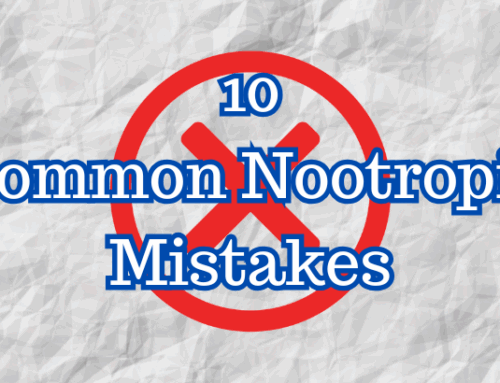Aniracetam is one of the most popular nootropics being used around the world today. It is effective for a lot of people, has an excellent safety profile, and is readily available from a variety of online nootropic vendors (although it's gotten harder to find in recent years).
The benefits that aniracetam users report include increased focus, reduced anxiety, improved mood, faster learning, and better memory. But don't just take their word for it. There's plenty of science to support the safety and effectiveness of this potent nootropic.
In this article, we're going to take an in-depth look at aniracetam's benefits, safety, dosage, and other relevant info. But first, let's see what exactly aniracetam is.
What Is Aniracetam
This is a popular nootropic that is a member of the racetam family.1 The racetams are chemically-similar compounds – many of which are nootropics – and include piracetam, phenylpiracetam, oxiracetam, and several others. Aniracetam, known by chemists as N-anisoyl-2-pyrrolidinone, is sold as a prescription drug in Europe under the brand names Sarpul, Memodrin, Referan, Draganon, and Ampamet.2
While researchers were experimenting with piracetam in the 1970s, making slight alterations to the molecule, aniracetam was created.3 Since then it has been used as a prescription medication in Europe and other parts of the world to treat a variety of conditions. And over the past decade or two, aniracetam has become popular among nootropic users. They often report that it can decrease anxiety, increase focus, and do a whole lot more. But we'll get to aniracetam's benefits in the next section. First, let's take a look at how aniracetam works.
One of the ways that aniracetam works in the brain is by modulating AMPA receptors.4 These receptors are located all throughout the nervous system (including the brain) and play a vital role in communication between cells.5
 Aniracetam is also known to affect serotonin, dopamine, and glutamate receptors.6 These are all well-known neurotransmitters that assist in communication between neurons (aka nerve cells, which include brain cells). Serotonin is known to play a role in mood, appetite, and sleep. Dopamine plays a role in motivation, pleasure, libido, and anxiety. And glutamate is involved in memory, learning, and a lot of other aspects of cognition.
Aniracetam is also known to affect serotonin, dopamine, and glutamate receptors.6 These are all well-known neurotransmitters that assist in communication between neurons (aka nerve cells, which include brain cells). Serotonin is known to play a role in mood, appetite, and sleep. Dopamine plays a role in motivation, pleasure, libido, and anxiety. And glutamate is involved in memory, learning, and a lot of other aspects of cognition.
Now that we've taken a look at what aniracetam is, let's explore some of its potential benefits. We'll see what nootropic users are reporting and take a look at the science to see if it supports these claims.
Aniracetam Benefits
Nootropic users have reported a wide variety of benefits from aniracetam. I've even had several experienced users tell me that, of all the nootropics they've tried, aniracetam is their favorite. Some of the benefits that people have reported from aniracetam include increased focus, reduced anxiety, improved mood, better memory, and overall cognitive enhancement. But what does the science have to say about this interesting substance? Let's dive in one benefit at a time.
Reduced Anxiety
 One of the most commonly reported benefits of aniracetam (and one of the most common reasons for use) is reduced anxiety. Users often report that they feel more relaxed and experience less unwanted thoughts. I should note that I've personally experienced this with aniracetam. Though there haven't yet been any rigorous human studies to test aniracetam's effect on anxiety, there have been some promising animal studies.
One of the most commonly reported benefits of aniracetam (and one of the most common reasons for use) is reduced anxiety. Users often report that they feel more relaxed and experience less unwanted thoughts. I should note that I've personally experienced this with aniracetam. Though there haven't yet been any rigorous human studies to test aniracetam's effect on anxiety, there have been some promising animal studies.
A study published in 2001 looked at the effect aniracetam had on three different mouse models of anxiety.7 Mice are often used in studies because the way they respond to drugs is strikingly similar to the way humans do. In all three models of anxiety, the mice given aniracetam showed reductions in anxiety and stress.
Improved Memory and Learning
 Another widely reported benefit of aniracetam is improved memory and learning. Users often report that they find it easier to remember words and to memorize new ones. And there are several human and animal studies to support these claims.
Another widely reported benefit of aniracetam is improved memory and learning. Users often report that they find it easier to remember words and to memorize new ones. And there are several human and animal studies to support these claims.
A study published in 2012 looked at the effect aniracetam had on patients with cognitive impairment.8 Researchers compared the effectiveness of aniracetam to cholinesterase inhibitors (ChEIs), drugs used to treat things like dementia and Alzheimer's disease. Participants were given either aniracetam, a ChEI, aniracetam and a ChEI together, or placebo. Out of all four groups, the participants in the aniracetam-only group had the best long-term outcomes.
An animal study from 1982 looked at the effects that aniracetam has on learning and memory in rodents.9 The researchers noted 6 distinct positive effects that aniracetam had. These included improved learning, better memory, and the prevention of drug-induced amnesia.
It's worth noting that a more-recent study published in 2019 found that aniracetam did not improve the memory of healthy pigeons.14 The study's authors note that while there is evidence that aniracetam may be able to reverse memory impairment to some extent, there doesn't seem to be much empirical evidence that it can improve the memory of healthy animals including humans. Hopefully more research will be done in the future to get a better picture of how exactly aniracetam effects the memory of both healthy and cognitively-impaired individuals.
Improved Mood
 Another nootropic benefit that aniracetam users report is improved mood. Some aniracetam users have even said in online forums that it works better than the prescription antidepressants they've tried when it comes to lasting improvements in mood. Of course, human studies are needed before this can be stated conclusively, but preliminary animal research is promising.
Another nootropic benefit that aniracetam users report is improved mood. Some aniracetam users have even said in online forums that it works better than the prescription antidepressants they've tried when it comes to lasting improvements in mood. Of course, human studies are needed before this can be stated conclusively, but preliminary animal research is promising.
A study done in 2001 looked at the effect aniracetam had on rats.10 The results of the study showed that, while aniracetam didn't seem to have an antidepressant effect on younger rats, it did have one for aged rats.
Another animal study from 2002 showed similar results.11 Researchers wanted to see the effects that a number of different racetams – one of them being aniracetam – had on rats. They found aniracetam to have an antidepressant-like effect. The researchers also noted that aniracetam's antidepressant effect came on faster than that of fluoxetine (Prozac), a common prescription antidepressant they compared it to.
Increased Focus
 Yet another benefit that aniracetam users often report is an increase in focus. While I couldn't find any human or animal studies that explore this directly, it's not hard to understand why this benefit might be so commonly reported. And it's a benefit that I've personally experienced with aniracetam.
Yet another benefit that aniracetam users often report is an increase in focus. While I couldn't find any human or animal studies that explore this directly, it's not hard to understand why this benefit might be so commonly reported. And it's a benefit that I've personally experienced with aniracetam.
If you have a lot of unchecked anxiety, are constantly in a bad mood, or have trouble remembering things, odds are you have trouble focusing, too. Personally, I have dealt with anxiety issues off and on for years. And when I'm really anxious, I can't focus on anything except my anxiety. When I take aniracetam, it reduces my anxiety to a point where I'm not focused on it and I can devote my attention to other things. It's not unreasonable to assume aniracetam's focus-enhancing effect might be the byproduct of its anxiety-reducing, mood-improving, and memory-enhancing properties.
Aniracetam Dosage
![]() Aniracetam is usually taken in a dosage of 750-1,500 milligrams (mg) a day.1 Most people who respond to aniracetam find dosages within this range to be effective. It's often taken twice a day. So for someone who is taking an aniracetam dosage of 1,500 mg a day, that'll usually be taken in two 750 mg doses.
Aniracetam is usually taken in a dosage of 750-1,500 milligrams (mg) a day.1 Most people who respond to aniracetam find dosages within this range to be effective. It's often taken twice a day. So for someone who is taking an aniracetam dosage of 1,500 mg a day, that'll usually be taken in two 750 mg doses.
Aniracetam can be taken with or without food. However, since it is fat soluble, it's often suggested that aniracetam be taken with food. Eating a small meal, one that contains some fats (saturated or unsaturated doesn't matter) may help your body to absorb aniracetam better.

That being said, aniracetam capsules have become harder to find in recent years. Like all the other racetams, you won't find aniracetam at places like Amazon – only certain online nootropic vendors. Though aniracetam capsules have gotten harder to find, Science.bio still offers high-quality aniracetam powder.
Aniracetam Negative Effects
![]() Aniracetam has been shown to be very well-tolerated. In clinical trials (human studies), up to 1,500 mg of aniracetam daily for several months straight has been shown to be very safe.12 Negative effects are rare and may include headache, nausea, upset stomach, anxiety, and diarrhea. For the few people who do experience these unwanted effects, discontinuing aniracetam makes them quickly go away.
Aniracetam has been shown to be very well-tolerated. In clinical trials (human studies), up to 1,500 mg of aniracetam daily for several months straight has been shown to be very safe.12 Negative effects are rare and may include headache, nausea, upset stomach, anxiety, and diarrhea. For the few people who do experience these unwanted effects, discontinuing aniracetam makes them quickly go away.
Like any time you're thinking about starting a new supplement, diet, fitness program, or behavioral routine, it's a good idea to talk to your doctor first. That being said, most physicians don't know what aniracetam is. So you may have to educate them about it. The References section at the bottom of the page may be a good place to start.
And to be clear: While some studies and anecdotal reports show that aniracetam can improve mood and reduce anxiety, it is not approved to treat any clinical mood-or-anxiety disorders. If you're suffering from a diagnosable mental-health disorder, talk to a licensed healthcare provider about treatment options.
Conclusion
 Of all the racetams being used for their nootropic benefits, aniracetam remains one of the most popular. It is especially sought after by people who suffer from sub-clinical anxiety. Though more human studies are needed to further explore aniracetam's potential, the research that has been done is incredibly promising. And while everyone responds to nootropics differently, I can tell you from personal experience that aniracetam definitely helps me to feel less anxious, to focus, and to be more productive in general.
Of all the racetams being used for their nootropic benefits, aniracetam remains one of the most popular. It is especially sought after by people who suffer from sub-clinical anxiety. Though more human studies are needed to further explore aniracetam's potential, the research that has been done is incredibly promising. And while everyone responds to nootropics differently, I can tell you from personal experience that aniracetam definitely helps me to feel less anxious, to focus, and to be more productive in general.
If you'd like to learn about the very first nootropic and the one aniracetam was created from, read this: Piracetam – The First Nootropic.
Have you used aniracetam? What nootropic (and other) benefits have you noticed? Any negative effects? Please leave your answers in the comments section at the bottom. And if you haven't already, sign up for the Nootropics Zone newsletter below to learn more about aniracetam and lots of other interesting nootropics.
To learn more about nootropics, sign up for the Nootropics Zone newsletter. You'll get the free gift, The Ultimate Nootropics Quick Reference Guide.
References
1Aniracetam. (n.d.). Examine.com. Retrieved November 3, 2023 from https://examine.com/supplements/aniracetam/
2Aniracetam. (n.d.). Wikipedia. Retrieved November 3, 2023 from https://en.wikipedia.org/wiki/Aniracetam
3Kyburz, E. (1979). U.S. Patent No. EP0005143. Washington, DC: U.S. Patent and Trademark Office.
4Ito, I., Tanabe, S., Kohda, A., & Sugiyama, H. (1990). Allosteric potentiation of quisqualate receptors by a nootropic drug aniracetam. The Journal of Physiology, 424:533-43.
5Yadav, R., Dravid, S., Yuan, H., & Traynelis, S. (2016). AMPA receptors: molecular biology and pharmacology. In Curated References Collection in Neuroscience and Biobehavioral Psychology (pp. 311-18). Elsevier Science Ltd.
6Nakamura, K. (2002). Aniracetam: its novel therapeutic potential in cerebral dysfunction disorders based on recent pharmacological discoveries. CNS Drug Reviews, 8(1):70-89.
7Nakamura, K., & Kurasawa, M. (2001). Anxiolytic effects of aniracetam in three different mouse models of anxiety and the underlying mechanism. European Journal of Pharmacology, 420(1):33-43.
8Koliaki, C., Messini, C., & Tsolaki, M. (2012). Clinical efficacy of aniracetam, either as monotherapy or combined with cholinesterase inhibitors, in patients with cognitive impairment: a comparative open study. CNS Neuroscience & Therapeutics. 18(4):302-12.
9Cumin, R., Bandle, E., Gamzu, E., & Haefely, W. (1982). Effects of the novel compound aniracetam (Ro 13-5057) upon impaired learning and memory in rodents. Psychopharmacology (Berl). 78(2):104-11.
10Nakamura, K., & Tanaka, Y. (2001). Antidepressant-like effects of aniracetam in aged rats and its mode of action. Psychopharmacology (Berl). 158(2):205-12.
11Knapp, R., Goldenberg, R., Shuck, C., Cecil, A., Watkins, J., et al. (2002). Antidepressant activity of memory-enhancing drugs in the reduction of submissive behavior model. European Journal of Pharmacology. 440(1):27-35.
12Lee, C., & Benfield, P. (1994). Aniracetam. An overview of its pharmacodynamic and pharmacokinetic properties, and a review of its therapeutic potential in senile cognitive disorders. Drugs & Aging. 4(3):257-73.
14Phillips, H., McDowell, A., Mielby, B., Tucker, I., & Colombo, M. (2019). Aniracetam does not improve working memory in neurologically healthy pigeons. PLoS One. 14(4).
[Originally published July 15, 2015. Updated November 3, 2023.]







Leave a Reply